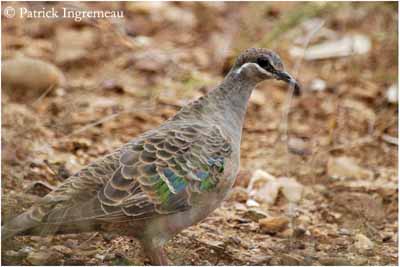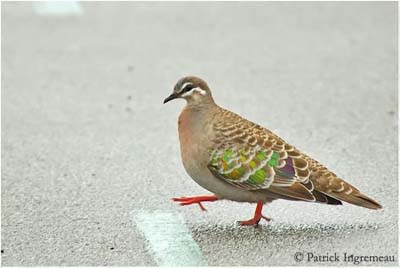
Common Bronzewing
Phaps chalcoptera
Columbiforme Order – Columbidae Family
BIOMETRICS:
Length : 32-36 cm
Weight : 230-390 g
DESCRIPTION:
Common Bronzewing is a fairly large bird with plump body and small head. It is endemic to Australia.
PROTECTION / THREATS / STATUS:
Common Bronzewing is common in its range, and seems to be secure throughout the continent, despite illegal shooting in some parts of the range, and habitat loss for grazing and agriculture.
Fr: Colombine lumachelle
All : Bronzeflügeltaube
Esp : Paloma-bronce Común
Ital : Colomba ali bronzine
Nd : Bronsvleugelduif
Russe : Обыкновенный бронзовокрылый голубь
Photographs by Patrick Ingremeau
TAMANDUA
Text by Nicole Bouglouan
Sources :
HANDBOOK OF THE BIRDS OF THE WORLD vol 4 by Josep del Hoyo-Andrew Elliott-Jordi Sargatal - Lynx Edicions - ISBN: 8487334229
PIGEONS AND DOVES by David Gibbs, Eustace Barnes and John Cox - Pica Press Sussex - ISBN: 1873403607
Birds in backyards (Birds Australia and Australian Museum)
Wikipedia (Wikipedia, The Free Encyclopedia)
Welcome to the Australian Museum

Adult male has dark brownish-olive upperparts, with pale buff fringes to feathers giving distinct scaled pattern. Upper wings show fiery metallic bronze, orange and red patches, and grey feather tips forming regular bars across coverts. Upper tail shows brownish central feathers. External rectrices are greyish, with broad black subterminal band.
Underparts are vinous-pink, brighter on breast. Belly is browner, and vent is greyer.
On the head, forehead is bright buff. Crown and nape are olive-brown. Lores and eye-ring are black. We can see a conspicuous white line starting from the base of the bill, under the eyes, ending to the rear of ear coverts, forming an incomplete V on hind neck. Neck sides are grey, from cheeks to scapulars. Bill is blackish. Eyes are reddish-brown. Legs and feet are purplish-red.
Adult female has grey forehead and crown. White line is narrower and duller. Neck sides are brownish. Underparts are duller than in male.
Juvenile has dull brown upperparts, without any iridescence on wing coverts. Underparts are greyish. Head is purple-brown. It lacks white line, but we can see pale grey patch from bill, under the eyes to ear coverts. Bill, legs and feet are duller than in adults.
VOICE: SOUNDS BY XENO-CANTO
Common Bronzewing utters low, deep “ooom” as advertising call, while it slightly bows the head. This call is repeated several times in long series. It also gives softer, but more rapid version of the same sounds. Alarm call is a growling.
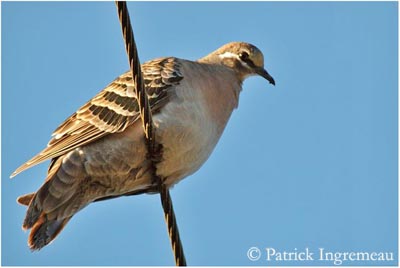
HABITAT:
Common Bronzewing can live in wide variety of habitats, but it will avoid too dense rainforests and treeless areas. It can be found in open dry woodlands and savannahs with shrubs, with an access to water. We can also find this species in cultivated areas with close trees and bushes.
RANGE:
Common Bronzewing lives in Australia, throughout the mainland. It is also found in Tasmania, except in the south-west, and islands.
BEHAVIOUR:
Common Bronzewing feeds mainly on the ground, eating seeds and plant matter. It is often seen in pairs or in small groups, but they gather in large flocks at waterholes. These birds need to drink regularly by day and by night. Common Bronzewing can take berries from low branches and bushes, and also feeds on cultivated grains.
When alarmed or threatened, Common Bronzewing crouches on the ground among vegetation, to avoid detection. If it flushes, it takes off readily, with loud clapping of wings.
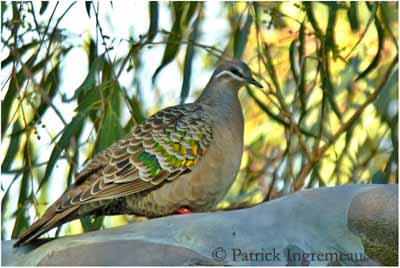
During breeding period, male performs some displays on the ground, such as bowing displays. It displays its iridescent wing-coverts with half-open wings, tail is fanned and raised, and head and breast are lowered and rapidly bowed forwards, while it gives a soft “coo”.
Common Bronzewing roosts on branches or perches in trees at night.
It is sedentary in its range, performing local dispersion, or travelling long distances for water and better climatic conditions, according to their range.
FLIGHT:
Common Bronzewing has strong, fast and direct flight. It flies low from the ground, performing continuous wing beats in a steady manner.
REPRODUCTION:
Breeding season occurs mainly from August to January, but may be extended through the year.
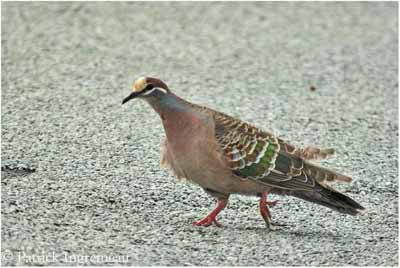
Common Bronzewing breeds in trees or bushes. Nest is a loose platform made with twigs and sticks, usually low in vegetation, but also up to 20 metres above the ground.
Female lays 2 creamy-white eggs. Incubation lasts about 2 weeks, shared by both adults.
Altricial chicks are fed with crop milk by both parents. Young can fly at about 16 days of age, but they remain at nest about 25 days, before to fledge.
DIET:
Common Bronzewing feeds mainly on seeds, and other plant matter such as berries, weeds and grass seeds, and sometimes leaves and small invertebrates.
